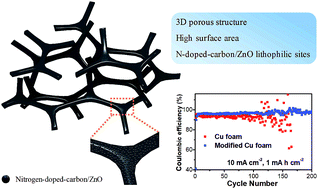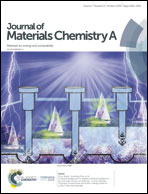A nitrogen-doped-carbon/ZnO modified Cu foam current collector for high-performance Li metal batteries†
Abstract
The two most challenging issues for Li metal anodes are large volume change during the plating/stripping process and the growth of Li dendrites induced by uneven Li deposition. They lead to low coulombic efficiency, short cycling lifespan and serious safety issues of Li metal batteries. Here we developed a facile strategy to prepare a nitrogen-doped-carbon/ZnO (NDC/ZnO) modified Cu foam (MCuF) current collector for Li metal anodes. The MCuF shows stable Li plating/stripping behavior with the Li dendrite-mitigation feature. The resultant half cells achieve a super long lifespan of over 600 cycles at 1 mA cm−2 and over 200 cycles at a high current density 10 mA cm−2. Moreover, the full cell paired with LiFePO4 also exhibits a long lifespan of over 150 cycles at a high rate of 5C. Such high performance can be attributed to the characteristics of MCuF, including its 3D porous structure with high conductivity, enlarged surface area and uniform lithophilic NDC/ZnO sites. We believed that our work can provide a facile strategy for fabricating high-performance 3D current collectors for Li metal storage and stable Li metal batteries.



 Please wait while we load your content...
Please wait while we load your content...